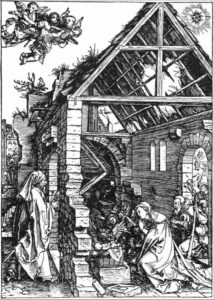by Gudrun Hutchins
The German city of Nürnberg has a long documented history dating back more than a thousand years. It was an independent “free” imperial city, making its own laws, minting its own currency and paying tribute to no specific ruler during the middle ages. It was one of the favorite cities of Holy Roman Emperor Charles IV who stayed within its walls 52 times and held the imperial diets or courts in Nürnberg Castle. Nürnberg became rich as one of the important cities on trade routes from Italy and Spain to northern Europe.
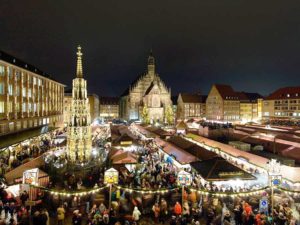
The cultural flowering of Nürnberg, in the 15th and 16th centuries, made it the center of the German Renaissance. The years between 1470 and 1530 are generally regarded as the city’s cultural heyday. Nürnberg traded in virtually all of the then-known world and Nürnberg’s wealth was known as “the Imperial Treasure Chest.”The city’s revenues were said to have been greater than those of the whole kingdom of Bohemia.
It was during this period that a large number of artists, sculptors, and craftsmen flourished. The best known at the present time is Albrecht Dürer, who studied the anatomy of cadavers to incorporate details of muscles and sinews into his etchings, and also created many Nativity etchings.
Nativity Etching by Albrecht Dürer (1509)
The Christmas Market was established to allow the artists and craftsmen to display and sell their wares to a large number of customers from other regions of Europe. Originally the artists and craftsmen had to be approved by the ruling body of the city to maintain the quality of the goods for sale. The earliest written records of such transactions date to the early sixteenth century.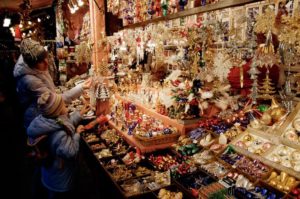
The present day Christmas market is still the largest in Germany and most of it is still set up in the main market square of the medieval city center. But during the last century a separate children’s market has been set up in an adjacent square. The sister cities market in a third square is the most recent addition.
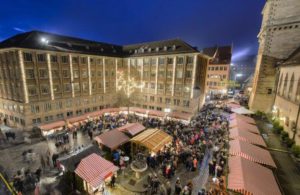
Since my aunt (an MD) and my uncle (a chemical engineer and beer brewmaster) lived in Nürnberg, I visited the Nürnberg Christmas Market several times as an adult after I had immigrated to the United States at the age of 10. Some of the photos of the happy children in the children’s market are my own and were taken on the sly without the children being aware of the photographer.
The most important person at the Christmas market is the “Christkind” or Christchild, personified by a young woman from Nürnberg who is chosen every two years.
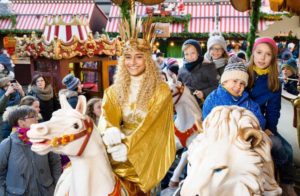
The historic figure is based on the medieval passion plays in which the angel of the annunciation is the main character and tells the story. The Christkind opens the Christmas market from the balcony of the large church (donated by Charles IV in the 14th century) on the Friday before the First Advent Sunday accompanied by a brass ensemble. She has a very busy December, traveling through the various market squares in a small carriage pulled by a white pony and delivers presents to the children in the hospital on Christmas Eve. She spends a lot of her time in the children’s market and the children all want to see her and be close to her. The little ones are also a bit afraid of her. She also participates in cultural programs in the children’s theater which adjoins the children’s market.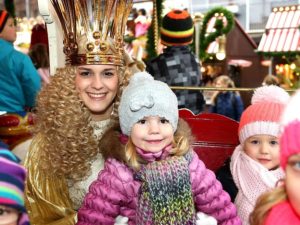
There are a lot of hands-on activities in the children’s market. In the bake house, children can make their own cookies: rolling out the dough, cutting out the shapes and decorating them with nuts or colored candies. They are popped into the oven and can be picked up 20 minutes later. Candles can be dyed in a variety of colors, and artworks can be assembled from different colors of sand. Various assistants are there to help and clean up; parents may watch but not participate. There are also two carousels, a small Ferris wheel and a small steam train for rides. And there is the hot punch to warm up if it is cold. Photographers like me end up with 50 photos.
Environmental Sustainability of the Christmas Market in Nürnberg
The city of Nürnberg practices a degree of sustainable development that would not be considered practical in the United States. The Christmas Market uses only renewable energy. The stalls are made of regional spruce and 30 of them date back to 1890.
 The hot mulled wine for adults and the hot punch for children is served in re-usable glass mugs decorated with the Christmas Market design of the current year. You pay a deposit for the mug and can keep it as a souvenir, have it refilled at another stall, or request a refund at a third stall which will then wash and re-use the mug. Voila no trash!
The hot mulled wine for adults and the hot punch for children is served in re-usable glass mugs decorated with the Christmas Market design of the current year. You pay a deposit for the mug and can keep it as a souvenir, have it refilled at another stall, or request a refund at a third stall which will then wash and re-use the mug. Voila no trash!

